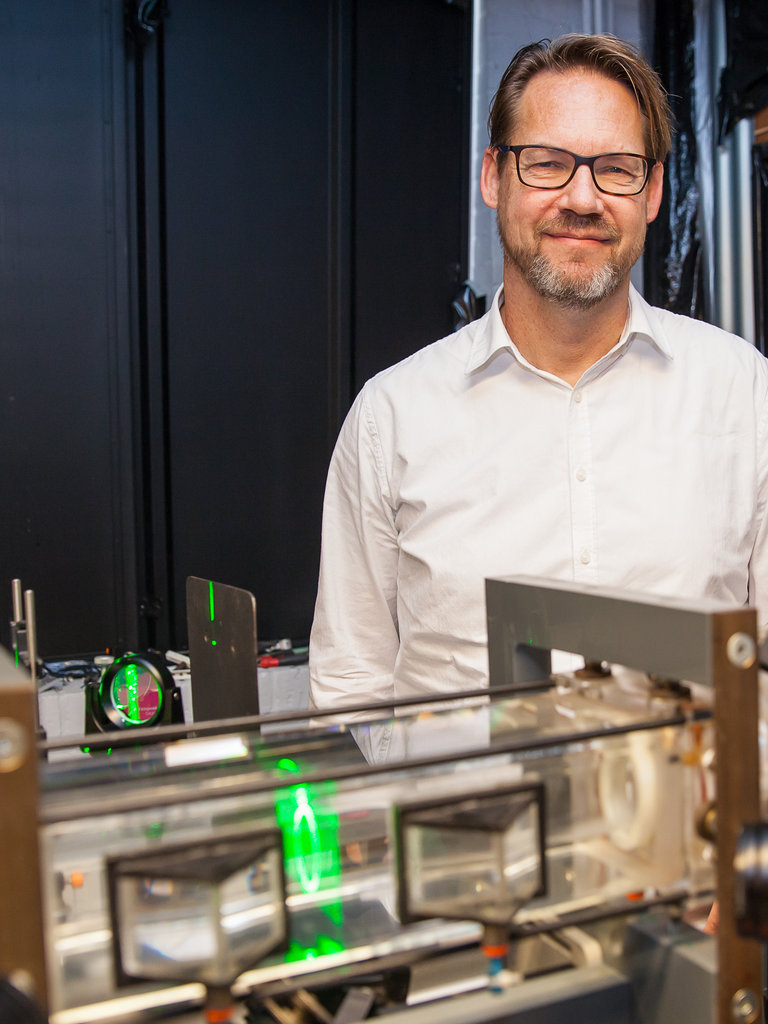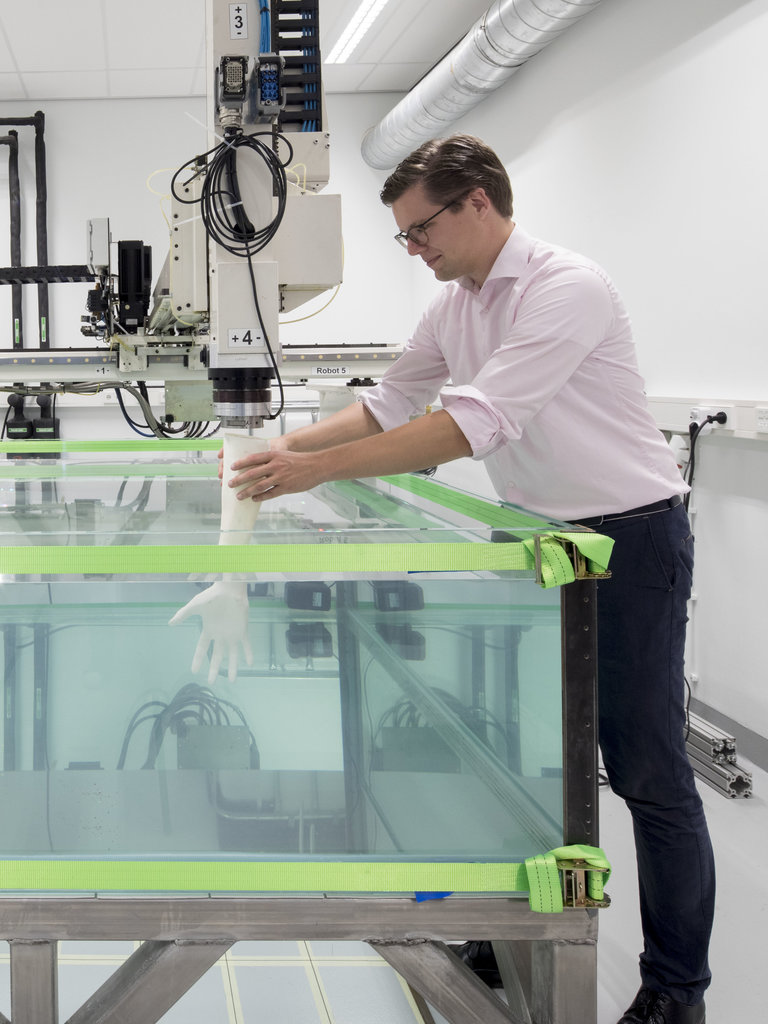Fluid mechanics are integral to many areas of our everyday life including sport, medicine, climate change and environmental issues as well as the more traditional fields of transport, energy and building infrastructure. For instance, Dr Jerry Westerweel, professor of Fluid Mechanics, has been involved in a fluid mechanics project as part of an investigation into swimming techniques. “I swim a lot myself and I began wondering whether it was better to keep my fingers together or slightly apart as I moved through the water. We did some research and finally my colleague realised that it all had to do with scale so we could apply the same law that we use to optimise wind turbines.” This law says that if a wind turbine with a lot of blades is fully closed, the friction would be so large that the wind would have to blow around it, reducing the turbine’s efficiency. So to improve efficiency, you have to keep the blades slightly open and let wind blow through. “In the same way, we realised that if you keep your fingers slightly apart, that also helps optimise swimming efficiency.”
100 years ago this year, the Delft University of Technology (DUT) appointed Dutch physicist Johannes Martinus Burgers to be the first ever professor of fluid mechanics in the Netherlands. Back then, in 1918, it was a time of exciting and rapid developments within the fields of transport, energy and industrial production, and people soon realised how important it was to study how gas and liquid flows affect the performance of aeroplanes, pipelines, and windmills, and to understand what forces are involved. A century later, and armed with better tools and more computer power, the Aero- and Hydrodynamics Laboratory of the DUT will mark the anniversary by considering the coming 100 years of fluid mechanics and how the field can best help society respond to the challenges of rapidly evolving technology, particularly in light of sustainability and climate change concerns.
As part of the centennial celebrations, Professor of Fluid Mechanics, Dr Jerry Westerweel is organising a symposium with forward-looking theme: 1918 => 2018 => 2118. Read more.
Turbulence
A particular interest of Professor Westerweel within fluid mechanics is turbulence which is the chaotic, or so-called non-linear, movement of fluids. “Most people understand turbulence as a nasty feeling when a plane is taking off or being blown off your bike but it’s a phenomenon that occurs in many situations, and not just bad ones.” Take pollution for example. Modern life in a big city usually means air pollution: “Turbulence will mix the clean air in the upper atmosphere with the more polluted air in the lower levels so if it wasn’t for turbulence, we couldn’t live in a city!”
As part of his early research into turbulence, Westerweel developed a now widely-used technique called Particle Image Velocimetry. “When I was a PhD student, the instruments were all single point measurements which meant visualising a flow was like trying to imagine a painting by just looking through a tiny hole – you can look here and you can look there but you don’t get the big picture. So we worked on a way to visualise a flow by basically putting smoke in a box to see and trying to see how the flow was behaving. In the early days, it was very qualitative but now, with computers and digital cameras, we can measure it and actually look at the flow patterns.” So how does it work? “We put a lot of particles in the flow, illuminating it with a strong laser light and we can see 100,000 particles. At first, we could only visualise in one plane, but these days, we use six high-speed cameras to reconstruct the whole volume and so we can really measure everything we want to know about these flows. So that’s something to be proud of - working on a technique that everyone is now using to understand much more about flows.”
Particle Image Velocimetry has also helped us understand the forces involved in causing turbulence which in term could be applied to make transport smoother. For instance with ships where people are experimenting with air bubbles as a way of reducing friction, and so ‘lubricating’ a ship’s passage through water. “We see turbulence all the time,” says Westerweel, “yet the funny thing is that we don’t totally understand that transition point from a smooth flow of water from a tap, say, to the next moment when the flow is splashy or turbulent.”
Although fluid mechanics may lack the glamour of high energy physics or cosmology, it’s a study with an enormous range of applications and Professor Westerweel hopes that the centennial celebrations will get people thinking about the future of fluid mechanics. “Yes it should be a time of reflection, to ask what are the problems we really want to work on and how we’re going to deal with a future where everything is going to happen more and more quickly.”
Turbulence
A particular interest of Professor Westerweel within fluid mechanics is turbulence which is the chaotic, or so-called non-linear, movement of fluids. “Most people understand turbulence as a nasty feeling when a plane is taking off or being blown off your bike but it’s a phenomenon that occurs in many situations, and not just bad ones.” Take pollution for example. Modern life in a big city usually means air pollution: “Turbulence will mix the clean air in the upper atmosphere with the more polluted air in the lower levels so if it wasn’t for turbulence, we couldn’t live in a city!”
As part of his early research into turbulence, Westerweel developed a now widely-used technique called Particle Image Velocimetry. “When I was a PhD student, the instruments were all single point measurements which meant visualising a flow was like trying to imagine a painting by just looking through a tiny hole – you can look here and you can look there but you don’t get the big picture. So we worked on a way to visualise a flow by basically putting smoke in a box to see and trying to see how the flow was behaving. In the early days, it was very qualitative but now, with computers and digital cameras, we can measure it and actually look at the flow patterns.” So how does it work? “We put a lot of particles in the flow, illuminating it with a strong laser light and we can see 100,000 particles. At first, we could only visualise in one plane, but these days, we use six high-speed cameras to reconstruct the whole volume and so we can really measure everything we want to know about these flows. So that’s something to be proud of - working on a technique that everyone is now using to understand much more about flows.”
Particle Image Velocimetry has also helped us understand the forces involved in causing turbulence which in term could be applied to make transport smoother. For instance with ships where people are experimenting with air bubbles as a way of reducing friction, and so ‘lubricating’ a ship’s passage through water. “We see turbulence all the time,” says Westerweel, “yet the funny thing is that we don’t totally understand that transition point from a smooth flow of water from a tap, say, to the next moment when the flow is splashy or turbulent.”
Although fluid mechanics may lack the glamour of high energy physics or cosmology, it’s a study with an enormous range of applications and Professor Westerweel hopes that the centennial celebrations will get people thinking about the future of fluid mechanics. “Yes it should be a time of reflection, to ask what are the problems we really want to work on and how we’re going to deal with a future where everything is going to happen more and more quickly.”


